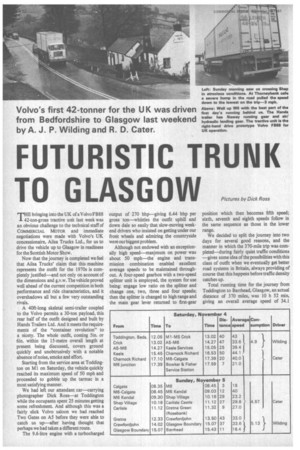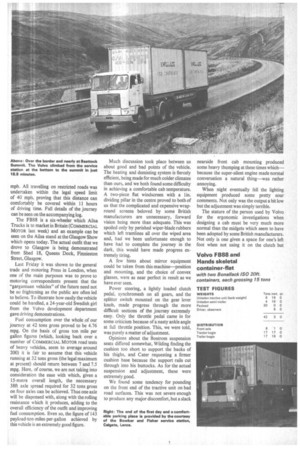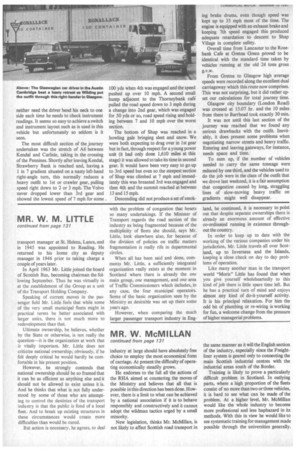FUTURISTIC TRUNK
Page 134

Page 135

Page 136

If you've noticed an error in this article please click here to report it so we can fix it.
TO GLASGOW Pictures Dick
E bringing into the UK of a V olvo FB88 42-ton-gross tractive unit last week was an obvious challenge to the technical staff of COMMERCIAL MOTOR and immediate negotiations were made with Volvo's UK concessionaire, Ailsa Trucks Ltd., for us to drive the vehicle up to Glasgow in readiness for the Scottish Motor Show.
Now that the journey is completed we feel that Ailsa Trucks' claim that this machine represents the outfit for the 1970s is completely justified-and not only on account of the dimensions and gx.w. The vehicle proved well ahead of the current competition in both performance and ride characteristics, and it overshadows all but a few very outstanding rivals.
A 40ft-long skeletal semi-trailer coupled to the Volvo permits a 30-ton payload, this rear half of the outfit designed and built by Hands Trailers Ltd. And it meets the requirements of the "container revolution" to a nicety. The whole outfit, coming Sin, or 6in. within the 15-metre overall length at present being discussed, covers ground quickly and unobtrusively with a notable absence of noise, smoke and effort.
Starting from the service area at Toddington on M1 on Saturday, the vehicle quickly reached its maximum speed of 50 mph and proceeded to gobble up the tarmac in a most satisfying manner.
We had left our attendant car-carrying photographer Dick Ross-at Toddington while the occupants spent 25 minutes getting some refreshment. And although this was a fairly slick Volvo saloon we had reached Two Gates on A5 before they were able to catch us up-after having thought that perhaps we had taken a different route.
The 9.6-litre engine with a turbocharged output of 270 bhp-'-giving 6.44 bhp per gross ton-whistles the outfit uphill and down dale so easily that slow-moving weekend drivers who insisted on getting under our front wheels and admiring the countryside were our biggest problem.
Although not endowed with an exceptionally high speed-maximum on power was about 50 mph-the engine and transmission combination enabled excellent average speeds to be maintained throughout. A four-speed gearbox with a two-speed splitter unit is employed, the system for use being: engage low ratio on the splitter and change one, two, three and four speeds; then the splitter is changed to high range and the main gear lever returned to first-gear position which then becomes fifth speed; sixth, seventh and eighth speeds follow in the same sequence as those in the lower range.
We decided to split the journey into two days for several good reasons, and the manner in which the 370-mile trip was completed-during fairly quiet traffic conditions -gives some idea of the possibilities with this class of outfit when we eventually get better road systems in Britain, always providing of course that this happens before traffic density catches up.
Total running time for the journey from Toddington to Barrhead, Glasgow, an actual distance of 370 miles, was 10 h 52 min, giving an overall average speed of 34.1
Above: Over the border and nearly at Beattock Summit. The Volvo climbed from the service station at the bottom to the summit in just 16.5 minutes.
mph. All travelling on restricted roads was undertaken within the legal speed limit of 40 mph, proving that this distance can comfortably be covered within 11 hours of driving time. Full details of the journey can be seen on the accompanying log.
The FB88 is a six-wheeler which Ailsa Trucks is to market in Britain (COMMERCIAL MOTOR last week) and an example can be seen on the Ailsa stand at the Glasgow Show which opens today. The actual outfit that we drove to Glasgow is being demonstrated from Shed 18, Queens Dock, Finnieston Street, Glasgow.
Last Friday it was shown to the general trade and motoring Press in London, when one of the main purposes was to prove to motoring correspondents present that the "gargantuan vehicles" of the future need not be so frightening as the public are often led to believe. To illustrate how easily the vehicle could be handled, a 24-year-old Swedish girl from the Volvo development department gave driving demonstrations.
Fuel consumption over the whole of our journey at 42 tons gross proved to be 4.76 mpg. On the basis of gross ton mile per gallon figures (which, looking back over a number of COMMERCIAL MOTOR road tests of heavy vehicles, seem to average around 200) it is fair to assume that this vehicle running at 32 tons gross (the legal maximum at present) should return between 7 and 7.5 mpg. Here, of course, we are not taking into consideration the ease with which, given a 15-metre overall length, the neccessary 38ft axle spread required for 32 tons gross on four axles can be achieved. Thus one axle will be dispensed with, along with the rolling resistance which it produces, adding to the overall efficiency of the outfit and improving fuel consumption. Even so, the figure of 143 payload-ton-miles-per-gallon achieved by this vehicle is an extremely good figure.
Much discussion took place between us about good and bad points of the vehicle. The heating and demisting system is fiercely efficient, being made for much colder climates than ours, and we both found some difficulty in achieving a comfortable cab temperature. A two-piece flat windscreen with a lin. dividing pillar in the centre proved to both of us that the complicated and expensive wrapround screens beloved by some British manufacturers are unnecessary, forward vision being more than adequate. This was spoiled only by perished wiper-blade rubbers which left tramlines all over the wiped area and, had we been unfortunate enough to have had to complete the journey in the dark, this would have made progress extremely tiring.
A few hints about mirror equipment could be taken from this machine—position and mounting, and the choice of convex glasses, were as near perfect in result as we have ever seen.
Power steering, a lightly loaded clutch pedal, synchromesh on all gears, and the splitter switch mounted on the gear lever knob, made progress through the more difficult sections of the journey extremely easy. Only the throttle pedal came in for some criticism because of a nasty ankle angle at full throttle position. This, we were told, was purely a matter of adjustment.
Opinions about the Bostrom suspension seats differed somewhat, Wilding finding the cushion too short to support the backs of his thighs, and Cater requesting a firmer cushion base because the support rails cut through into his buttocks. As for the actual suspension and adjustment, these were extremely good.
We found some tendency for pounding on the front end of the tractive unit on bad road surfaces. This was not severe enough to produce any major discomfort, but a slack
Right: The and of the first day and a comfortable parking place is provided by the courtesy of the Bowker and Fisher service station. Colgate, Lancs.
nearside front cab mounting produced some heavy thumping at these times which— because the super-silent engine made normal conversation a natural thing—was rather annoying.
When night eventually fell the lighting equipment produced some pretty sour comments. Not only was the output a bit low but the adjustment was simply terrible.
The stature of the person used by Volvo for the ergonomic investigations when designing a cab must be very much more normal than the midgets which seem to have been adopted by some British manufacturers. Not only is one given a space for one's left foot when not using it on the clutch but neither need the driver bend his neck to one side each time he needs to check instrument readings. It seems so easy to achieve a switch and instrument layout such as is used in this vehicle but unfortunately so seldom is it seen.
The most difficult section of the journey undertaken was the stretch of A6 between Kendal and Carlisle, taking in the crossing of the Pennines. Shortly after leaving Kendal, Strawberry Bank is reached and, having a 1 in 7 gradient situated on a nasty left-hand right-angle turn, this normally reduces a heavy outfit to 1st or crawler gear, pulling speed right down to 2 or 3 mph. The Volvo never dropped lower than 3rd gear and showed the lowest speed of 7 mph for some 100 yds when 4th was engaged and the speed pushed up over 10 mph. A second small hump adjacent to the Thomeybank cafe pulled the road speed down to 3 mph during a change into 2nd gear, which was engaged for 50 yds or so, road speed rising and holding between 7 and 10 mph over the worst section.
The bottom of Shap was reached in a howling gale bringing sleet and snow. We were both expecting to drag over in 1st gear but in fact, through respect for a young power unit (it had only done 1,610 miles at this stage) it was allowed to take its time in second gear. It would have been very easy to go up to 3rd speed but even so the steepest section of Shap was climbed at 7 mph and immediately this was breasted 3rd was engaged and then 46 and the summit reached at between 13 and 15 mph.
Descending did not produce a set of smok ing brake drums, even though speed was kept up to 35 mph most of the time. The engine is equipped with an exhaust brake and keeping 7th speed engaged this produced adequate retardation to descent to Shap Village in complete safety.
Overall time from Lancaster to the Rosebank Cafe at Gretna Green proved to be identical with the standard time taken by vehicles running at the old 24 tons gross g.v.w.
From Gretna to Glasgow high average speeds were recorded along the excellent dual carriageway which this route now comprises. This was not surprising, but it did rather upset our calculations for total journey time.
Glasgow city boundary (London Road) was crossed at 15.07 hr. and the 10 miles from there to Barrhead took exactly 30 mm.
It was not until this last section of the journey was reached that we found any serious drawbacks with the outfit. Inevitably, it does present some problems when negotiating narrow streets and heavy traffic. Entering and leaving gateways, for instance, needs space and time.
To sum up, if the number of vehicles needed to carry the same tonnage were reduced by one third, and the vehicles used to do the job were in the class of the outfit that we drove last weekend, it is a fair assumption that congestion caused by long, straggling lines of slow-moving heavy traffic on gradients might well disappear.




































































































































































































































































